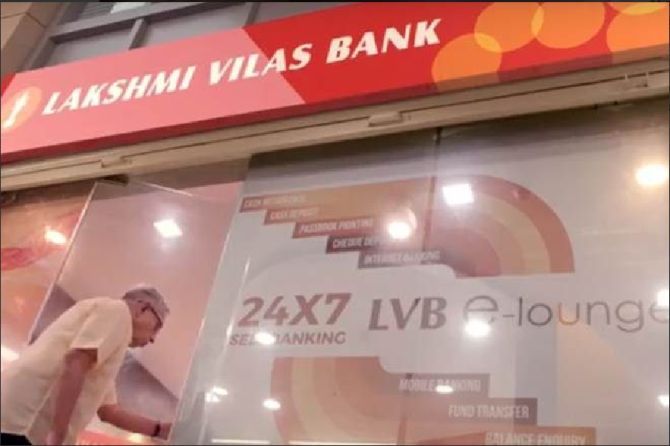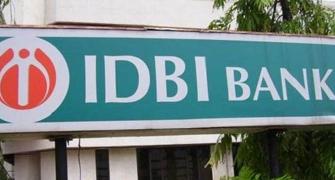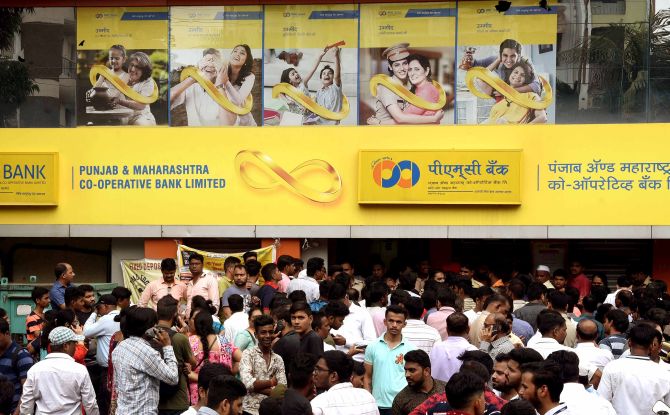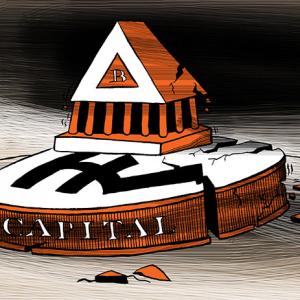'It's a toss-up between a fire sale of equity or merger with a strong bank,' points out Tamal Bandyopadhyay.

After the Reserve Bank of India rejected Indiabulls Housing Finance Ltd's plan to be merged with Lakshmi Vilas Bank Ltd (LVB), the housing finance company hopes to focus on the retail segment only.
A recent investor presentation on its new business model has a sub-title: 'The Phoenix Rises Again'.
What's happening at LVB?
Its share is now trading at a level last seen in 2003.
The triggers for the continuous erosion in shareholder value in this once-upon-a-time boutique community-based bank include the inability to raise capital to set aside money for bad loans, leading to ballooning losses.
The RBI bringing it under the ambit of 'prompt corrective action' (PCA), which restrains a bank's lending activities, and rejecting Indiabulls's proposal of being merged with LVB didn't help matters.
Indiabulls holds 4.99% stake in the bank.
It is easier to find why the bank has been put under PCA than why the merger plan was scuttled: Its huge bad loans, insufficient capital adequacy ratio, negative return on assets (RoA) for two consecutive years and its high leverage led to the PCA.
For the fiscal year 2019, LVB's net bad assets were 7.49% of its loan book, its capital adequacy ratio 7.72% and RoA 2.32%.
After its entry into the PCA zone, LVB had said it would make every effort to improve its financial health.
When the merger plan went kaput, it put up a brave front and said, 'This brings an end to recent uncertainty... the bank will continue to work towards raising capital'...
That's fine, but why hasn't it been able to raise capital so far?
It is a post-World War I bank, set up in 1926 at Karur on the banks of the river Amaravathi in Tamil Nadu, by a group of small businessmen belonging to the Vysya community to fund small businesses.
The entrepreneurial community was instrumental in setting up many banks in southern India -- Vysya Bank Ltd (which later was renamed ING Vysya and taken over by Kotak Mahindra Bank Ltd), Karur Vysya Bank Ltd and LVB, besides many smaller ones.
It also chipped in with the initial capital for Andhra Bank.
Seven businessmen at Karur, under the leadership of V S N Ramalingam Chettiar, set up LVB in the textile city of Tamil Nadu.
Between 1961 and 1965, it took over nine other banks and in the 1970s, it started expanding its footprint outside Tamil Nadu.
Till about a decade back, LVB was content being a small and beautiful bank, posting profits every year, giving handsome dividends to its investors but not bothering much about growth.
Things changed around 2008-2009 when the original Karur promoters let in others, also Vysyas, to take charge.
With that, an obsession for growth crept in, but none bothered to put in place the right vision and strategy for such growth.
Historically, LVB has rarely had continuity at the top-management level.
More often than not, the top management consisted retired public sector bankers, and the bank depended largely on walk-in businesses -- both for deposits as well as loans.
The sudden thrust on growth forced LVB to join most loan syndications with a small share, without understanding the implications.
Initially, it paid off as the interest income rose, as did profits.
The going was good till the RBI decided to conduct the asset quality review of Indian banks in 2015-2016.
The central bank's inspectors started checking all banks's books, suspecting ever-greening of loans.
Being part of loan syndications, LVB ended up having exposure to most large rotten accounts that have been dragged into the insolvency court.
That's how bad loans have been created, denting its interest income and forcing it to provide for such loans, eroding its capital.
The bank has been approaching investors to raise capital, but the fear of hidden bad loans and possible interference of the board/promoters in operations has kept them at bay.
Going by the media reports, about a year ago, a number of marquee investors showed interest, but nothing happened.
While the bank management has not explained why the deal was not closed, the investment community says the main reason is unreasonable valuation expectations.
These funds were not willing to play ball.
The last I heard, a large US financial services firm is in talks. Will it say yes?
The bank has been under the regulator's scanner for quite some time now.
In the past, the RBI had to appoint directors on its board and the tradition continues.
It scuttled the efforts of one of the promoters, a chartered accountant, to assume the chairmanship at the bank, but allowed another chartered accountant to don the mantle.
The promoter's wife, a qualified advocate, was on the board till recently.
The RBI, it seems, has not been happy with some alleged related-party transactions that happened in the bank.
The last MD and CEO quit in August, citing 'personal reasons'.
The LVB advertisement looking for a replacement promises an attractive package and an 'excellent working environment'.
Time is probably running out for LVB.
There aren't too many choices before it -- it's a toss-up between a fire sale of equity or merger with a strong bank.
Indiabulls had its compulsions: It desperately wanted a banking licence, but why would any bank in their right mind want to acquire LVB?
It will have takers at the right price as it has a good franchise with 570 branches, 85% of which are in south India and about half of that in Tamil Nadu. It has 1.8 million retail customers and the employees on the rolls are not too many -- about 5,000.
A bank with a predominant presence in the west and north may like to have it for the branch network alone, if the price is right.
A decade ago, HDFC Bank Ltd bought Centurion BoP Ltd primarily for the branch network.
Or else, it needs a white knight a la Fairfax India Holdings Corporation of Indian-born Canadian billionaire Prem Watsa.
Fairfax acquired a 51% stake in Catholic Syrian Bank in 2018 -- the first instance of a foreign company buying a majority stake in an Indian bank.
Under the current norms, foreign investors can own up to a 74% stake in a private bank but a single entity exposure is typically capped at 5% which can be raised to 10% with RBI approval.
Tamal Bandyopadhyay, a consulting editor with Business Standard, is an author and senior adviser to Jana Small Finance Bank Ltd.










